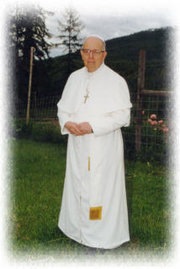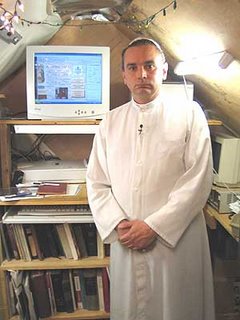Father Earl Lucian Pulvermacher, OFM Cap (born April 20, 1918) became Pope Pius XIII of the “true Catholic Church” October 24, 1998.
www.truecatholic.org. The “true Catholic Church” is a small group based in Montana, Which claims to be the “true” Catholic Church, as against all other groups or entities claiming that name.

Biography
Earl Pulvermacher is one of 9 children of catholic parents; Hubert Pulvermacher and Cecilia Lenerz. Four of their sons would become priest, two are still in communion with Rome and a brother Carl is a member of SSPX. He made Solemn Vows in the Capuchin Order on August 28, 1942 and Ordained a Priest on June 5, 1946. He chooses the religious name of Lucian.
Fr. Pulvermacher has served as a priest in Milwaukee, Wi. and as a missionary priest in Amami Oshima and Okinawa. From 1970 to 1976 Fr. Pulvermacher served in Australia. He left his order without dispensation in 1976 and for a time associated with some traditionalist Catholic organizations that opposed the doctrines of Vatican II.
After leaving Australia, Fr. Pulvermacher was affiliated with the Society of St. Pius X. His brother, Fr. Carl Pulvermacher, joined SSPX after Fr. Pulvermacher left and is still affiliated with the Society. After leaving the SSPX Fr. Pulvermacher established a circuit of private chapels throughout the U.S. claiming he had the authority to provide the Mass and Sacraments to these people. David Bawden, aka: Pope Michael I, demonstrated that Fr. Pulvermacher did not have such authority in an article entitled “
Jurisdiction During the Great Apostasy”. He then claimed that he had jurisdiction from the bishop in Okinawa (who was and still is in full communion with Rome). According to Canon Law a priest may hear confessions if he travels by boat or airplane, provided he has jurisdiction somewhere in the world. If he claimed authority from a Bishop in communion with “The Novus Ordo Church” then one can come to the conclusion that Fr. Pulvermacher was still in communion with that same church.
In the mid-1990 Fr. Pulvermacher became convince that Pope John XXIII had been a freemason and that his election as pope in 1958 had been invalid. This leads to the argument that not only John XXIII papacy and all his acts, such as calling for Vatican II and his encyclicals, were invalid but also this would cause a chain reaction by invalidating the conclave necessitated by John XIII death, the election of Paul VI, John Paul I, John Paul II, and Benedict XVI. According to Fr. Pulvermacher, the See of Peter has been vacant since the death of Pope Pius XII in 1958.
In 1998, a conclave of sedevacantist, both lay and clerical, in a telephone vote elected Fr. Pulvermacher to the “papacy“., and took the name Pius XIII. He has established his College of Cardinals to an ecclesiastical mechanism for the election of his successors.
Though he has followers, it seems that his main body of supporter is in Montana. Where his Papal Chair is situated is not clear. It could be in Montana where the Episcopal Ordination in a hotel ballroom following the Election that was attended by 28 people, but Karl Keating of Catholic Answers received a
letter from Pius XIII dated April 6th, 2004, that was postmarked “Springdale, Washington” .
It is noteworthy that he castigates seemly anyone who rejects his claim to be the true pope.



